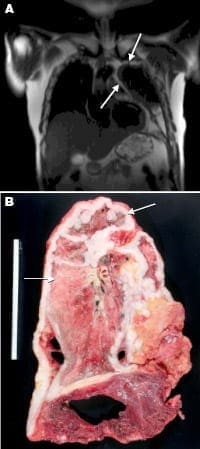
In the U.S. current statistics show between 2,000-3,000 people are diagnosed with malignant pleural mesothelioma each year. However, 10,000 Americans die each year from all asbestos-related diseases, according to statistics compiled by the Environmental Working Group. And, mesothelioma was not tracked as a specific cause of death by federal health officials until 1999, EWG points out, so actual totals for mesothelioma may be much higher.
Roughly 80% of malignant pleural mesothelioma cases start as pleural plaques. Pleural plaques are smooth, white, raised irregular areas of fibrous collagen tissue that develop on the pleura and vary in size from small to large. Pleural plaques are not considered pre-malignant, but they are an indication of exposure to asbestos (and thus indicate an increased risk of its associated diseases). They do not require treatment, but their presence should prompt regular medical check-ups.
To date, treatment options for mesothelioma have been limited as only a small number of patients respond to surgical intervention; however, recent efforts have focused on exploring new combinations of therapies for treating malignant pleural mesothelioma and extending survival.
Surgery
There have been some encouraging preliminary results in comparing surgery to conventional chemotherapy. At the American Society of Clinical Oncology meeting in Chicago in 2007, results were presented of a multi-center Phase II feasibility study of trimodal therapy for malignant pleural mesothelioma. Patients had four cycles of cisplatin and premextred chemotherapy, followed by an extrapleural pneumonectomy (explained in detail below), followed by hemithoracic radiation. Median survival time for the group was 16.6 months.
Extrapleural Pneumonectomy
Extrapleural pneumonectomy (EPP) is a surgical procedure that involves the removal of the lung along with its coverings. Of all treatment approaches attempted, extrapleural pneumonectomy has been most consistently associated with long-term disease-free survival. Also, with the lung removed, a higher amount of radiation can be delivered.
Once the patient is under complete general anesthesia, an incision is made extending from below the shoulder blade, around the side along the curvature of the ribs to the front of the chest on the side of the diseased lung (thoracotomy). Next, the surgeon collapses the diseased lung, cuts off its major blood vessels, and the lung’s main bronchial tube (air tube) will be clamped and cut and the lung removed. The pleura is then removed from the chest wall.
Go to Asbestos-Mesothelioma Case Evaluation Form >>
Read more at Mesothelioma & Asbestos-related Diseases Overview >>